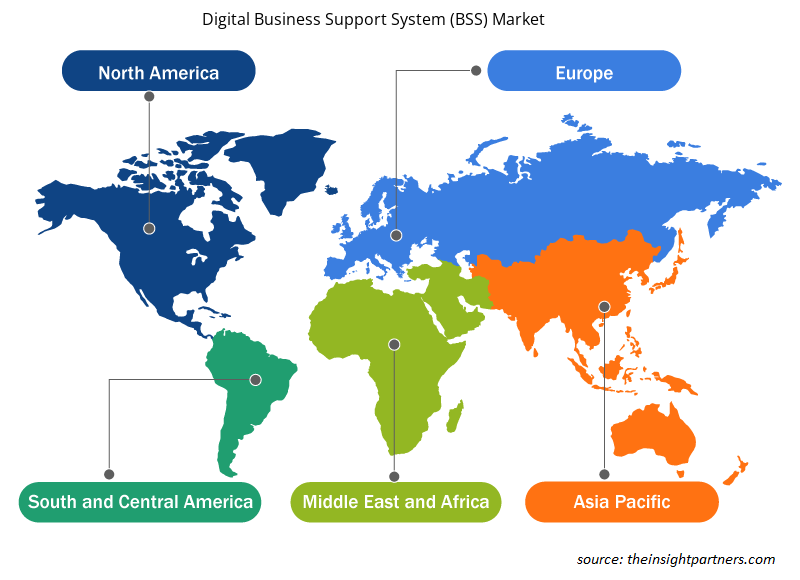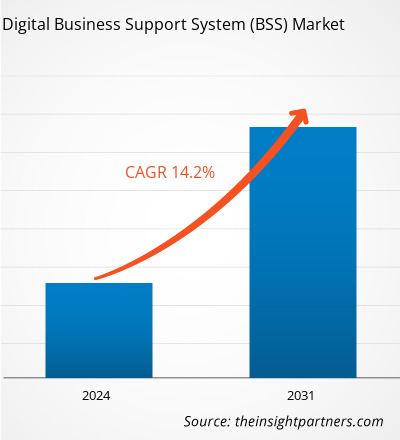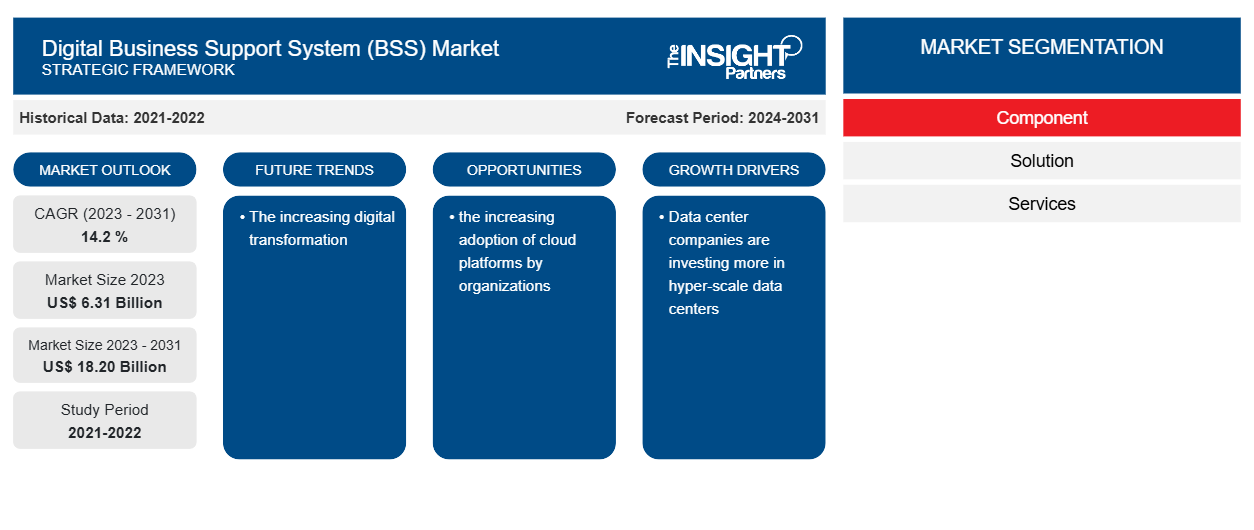Si prevede che la dimensione del mercato del Digital Business Support System (BSS) raggiungerà i 18,20 miliardi di dollari entro il 2031, rispetto ai 6,31 miliardi di dollari del 2023. Si prevede che il mercato registrerà un CAGR del 14,2% nel 2023-2031.ILÈ probabile che la crescente trasformazione digitale rimanga una tendenza chiave del mercato dei sistemi di supporto aziendale digitale (BSS).
Analisi di mercato del sistema di supporto alle imprese digitali (BSS)
Il mercato dei sistemi di supporto aziendale digitale sta crescendo rapidamente a causa di una serie di fattori, tra cui la crescente adozione di soluzioni BSS personalizzate e nuovi modelli commerciali, l'aumento della riduzione dei costi operativi, l'incremento delle transazioni online e l'uso di più dispositivi mobili, la crescente assunzione di soluzioni BSS basate su cloud, la crescente tendenza alla digitalizzazione nel settore delle telecomunicazioni e la crescente adozione di sistemi di supporto aziendale digitale da parte dei produttori al fine di aggiungere valore all'azienda massimizzando il ritorno sull'investimento, fornendo un servizio clienti superiore, riducendo i costi e accelerando il time-to-market per nuovi prodotti e servizi.
Panoramica del mercato dei sistemi di supporto alle imprese digitali (BSS)
Un sistema di supporto aziendale digitale è un tipo di piattaforma o soluzione che offre alle aziende commerciali vantaggi operativi e monitoraggio. L'accettazione degli ordini, le richieste relative ai pagamenti e la gestione dei ricavi dei clienti sono tutti parte del sistema di supporto aziendale. Oltre a offrire numerosi strumenti aggiuntivi di gestione delle operazioni, il sistema fornisce alle aziende approfondimenti sul marketing e sulle operazioni aziendali, che consentono loro di prendere decisioni consapevoli sui lanci di prodotti e sulle spese di marketing .
Personalizza questo report in base alle tue esigenze
Riceverai la personalizzazione gratuita di qualsiasi report, comprese parti di questo report, o analisi a livello nazionale, pacchetto dati Excel, oltre a usufruire di grandi offerte e sconti per start-up e università
-
Scopri le principali tendenze di mercato in questo rapporto.Questo campione GRATUITO includerà analisi di dati che spaziano dalle tendenze di mercato alle stime e alle previsioni.
Driver e opportunità di mercato del sistema di supporto alle imprese digitali (BSS)
Le aziende di data center stanno investendo sempre di più in data center di grandi dimensioni.
Numerose aziende di data center hanno effettuato investimenti significativi in data center iper-scala, che si prevede produrranno prospettive di espansione redditizie. Equinix ha rivelato l'intenzione di costruire circa 32 data center iper-scala in alcuni importanti mercati europei lo scorso anno. Investendo più di 6,9 miliardi di USD e avendo una capacità totale di oltre 600 megawatt, la società spera di migliorare la propria posizione nel mercato dei data center iper-scala in rapido sviluppo. La domanda per il mercato HCI nella regione aumenterà come risultato di questa espansione dei data center nell'area.Equinix revealed intentions to build about 32 hyper-scale data centers in a few significant European markets last year. Investing more than USD 6.9 billion and having a total capacity of over 600 megawatts, the company hopes to improve its standing in the rapidly developing hyper-scale data center market. The demand for the HCI market in the region will rise as a result of this expansion of the data centers in the area.
La crescente adozione di piattaforme cloud da parte delle organizzazioni
Si prevede che la crescente adozione di piattaforme cloud da parte delle organizzazioni, in particolare nelle nazioni emergenti, stimolerà la crescita del mercato Digital Business Support System nell'area Asia-Pacifico. Ad esempio, si prevede che l'adozione di carichi di lavoro cloud ibridi in India triplicherà dal 13% al 43%, secondo il Nutanix Cloud Index. La società si sta concentrando maggiormente sull'espansione aziendale e sullo sviluppo di nuovi prodotti come risultato del crescente utilizzo di tecnologie digitali per il coinvolgimento dei consumatori. Pertanto, si prevede che la crescente necessità di accuratezza e gestione dei dati presenterà nuove opportunità per gli operatori del mercato Digital Business Support System (BSS) durante il periodo di previsione.Nutanix Cloud Index. The corporation is focusing more on business expansion and new product development as a result of the increased use of digital technologies for consumer engagement. Thus, the increasing need for data accuracy and data management is anticipated to present new opportunities for the Digital Business Support System (BSS) Market players during the forecast period.
Analisi della segmentazione del rapporto di mercato del sistema di supporto alle imprese digitali (BSS)BSS) Market Report Segmentation Analysis
I segmenti chiave che hanno contribuito alla derivazione dell'analisi di mercato del Digital Business Support System (BSS) sono i componenti.BSS) Market analysis are components.
- In base al componente, il mercato Digital Business Support System (BSS) è segmentato in soluzioni e servizi. Il segmento dei servizi ha detenuto una quota di mercato maggiore nel 2023.BSS) Market is segmented into solutions and services. The services segment held a larger market share in 2023.
Analisi della quota di mercato del sistema di supporto alle imprese digitali (BSS) per area geograficaBSS) Market Share Analysis by Geography
L'ambito geografico del rapporto di mercato Digital Business Support System (BSS) è principalmente suddiviso in cinque regioni: Nord America, Asia Pacifico, Europa, Medio Oriente e Africa e Sud America/Sud e Centro America. In termini di fatturato, il Nord America ha rappresentato la quota di mercato più grande del Digital Business Support System (BSS). Rispetto ad altre regioni, il Nord America sta assistendo a una crescita più rapida nella cultura delle startup. L'emergere delle PMI e la crescente digitalizzazione del settore delle telecomunicazioni hanno contribuito all'espansione del mercato BSS digitale in Nord America. La crescente accessibilità delle soluzioni basate su cloud è un altro fattore che spinge l'adozione di soluzioni BSS digitali nella regione. Rispetto alle soluzioni on-premise convenzionali, le soluzioni BSS basate su cloud presentano una serie di vantaggi, come costi iniziali inferiori, maggiore sicurezza e scalabilità flessibile. Questi elementi contribuiranno probabilmente alla continua crescita del Nord America nell'adozione di soluzioni BSS digitali nei prossimi anni.
Approfondimenti regionali sul mercato del sistema di supporto alle imprese digitali (BSS)
Le tendenze regionali e i fattori che influenzano il mercato del Digital Business Support System (BSS) durante il periodo di previsione sono stati ampiamente spiegati dagli analisti di Insight Partners. Questa sezione discute anche i segmenti di mercato del Digital Business Support System (BSS) e la geografia in Nord America, Europa, Asia Pacifico, Medio Oriente e Africa e Sud e Centro America.

- Ottieni i dati specifici regionali per il mercato del sistema di supporto alle imprese digitali (BSS)
Ambito del rapporto di mercato del sistema di supporto aziendale digitale (BSS)
| Attributo del report | Dettagli |
|---|---|
| Dimensioni del mercato nel 2023 | 6,31 miliardi di dollari USA |
| Dimensioni del mercato entro il 2031 | 18,20 miliardi di dollari USA |
| CAGR globale (2023-2031) | 14,2% |
| Dati storici | 2021-2022 |
| Periodo di previsione | 2024-2031 |
| Segmenti coperti |
Per componente
|
| Regioni e Paesi coperti |
America del Nord
|
| Leader di mercato e profili aziendali chiave |
|
Densità degli attori del mercato del Digital Business Support System (BSS): comprendere il suo impatto sulle dinamiche aziendali
Il mercato del Digital Business Support System (BSS) sta crescendo rapidamente, spinto dalla crescente domanda degli utenti finali dovuta a fattori quali l'evoluzione delle preferenze dei consumatori, i progressi tecnologici e una maggiore consapevolezza dei vantaggi del prodotto. Con l'aumento della domanda, le aziende stanno ampliando le loro offerte, innovando per soddisfare le esigenze dei consumatori e capitalizzando sulle tendenze emergenti, il che alimenta ulteriormente la crescita del mercato.
La densità degli operatori di mercato si riferisce alla distribuzione di aziende o società che operano in un particolare mercato o settore. Indica quanti concorrenti (operatori di mercato) sono presenti in un dato spazio di mercato in relazione alle sue dimensioni o al valore di mercato totale.
Le principali aziende che operano nel mercato dei sistemi di supporto aziendale digitale (BSS) sono:
- Amdocs limitata
- Società controllata da Huawei
- Telefonaktiebolaget LM Ericsson
- Società di tecnologia NetCracker
- CSG Systems International, Inc.
- Optiva Inc.
Disclaimer : le aziende elencate sopra non sono classificate secondo un ordine particolare.

- Ottieni la panoramica dei principali attori del mercato dei sistemi di supporto alle imprese digitali (BSS)
Notizie di mercato e sviluppi recenti del sistema di supporto alle imprese digitali (BSS)
Il mercato del Digital Business Support System (BSS) viene valutato raccogliendo dati qualitativi e quantitativi dopo la ricerca primaria e secondaria, che include importanti pubblicazioni aziendali, dati associativi e database. Di seguito è riportato un elenco degli sviluppi nel mercato dei disturbi e delle strategie del linguaggio e della parola:
- Nel giugno 2023, IBM e Vista Equity Partners hanno firmato un accordo definitivo per l'acquisizione di Apptio Inc. da parte di IBM. Le capacità di automazione IT di IBM cresceranno più rapidamente a seguito dell'acquisizione di Apptio, offrendo ai dirigenti aziendali la possibilità di massimizzare il ritorno sui propri investimenti IT.
(Fonte: IBM, Comunicato stampa)
- Nel luglio 2022, Ericsson ha acquistato Vonage, portando avanti il piano dell'azienda di sfruttare la propria posizione di leader nella tecnologia per potenziare il business della rete mobile e penetrare nel mercato aziendale.
(Fonte: Ericsson, Comunicato Stampa)
Copertura e risultati del rapporto di mercato sul sistema di supporto alle imprese digitali (BSS)
Il rapporto "Dimensioni e previsioni del mercato del sistema di supporto aziendale digitale (BSS) (2021-2031)" fornisce un'analisi dettagliata del mercato che copre le seguenti aree:
- Dimensioni e previsioni del mercato a livello globale, regionale e nazionale per tutti i segmenti di mercato chiave coperti dall'ambito
- Dinamiche di mercato come fattori trainanti, vincoli e opportunità chiave
- Principali tendenze future
- Analisi dettagliata delle cinque forze PEST/Porter e SWOT
- Analisi di mercato globale e regionale che copre le principali tendenze di mercato, i principali attori, le normative e gli sviluppi recenti del mercato
- Analisi del panorama industriale e della concorrenza che copre la concentrazione del mercato, l'analisi della mappa di calore, i principali attori e gli sviluppi recenti
- Profili aziendali dettagliati
- Analisi storica (2 anni), anno base, previsione (7 anni) con CAGR
- Analisi PEST e SWOT
- Valore/volume delle dimensioni del mercato - Globale, Regionale, Nazionale
- Industria e panorama competitivo
- Set di dati Excel
Report recenti
Testimonianze
Motivo dell'acquisto
- Processo decisionale informato
- Comprensione delle dinamiche di mercato
- Analisi competitiva
- Analisi dei clienti
- Previsioni di mercato
- Mitigazione del rischio
- Pianificazione strategica
- Giustificazione degli investimenti
- Identificazione dei mercati emergenti
- Miglioramento delle strategie di marketing
- Aumento dell'efficienza operativa
- Allineamento alle tendenze normative























 Ottieni un campione gratuito per - Mercato dei sistemi di supporto aziendale digitale (BSS)
Ottieni un campione gratuito per - Mercato dei sistemi di supporto aziendale digitale (BSS)